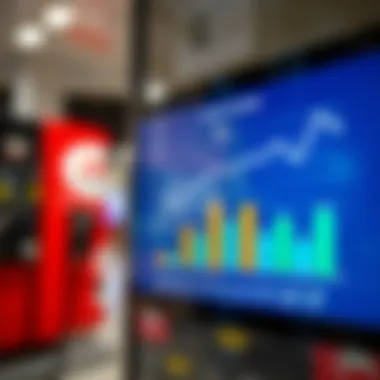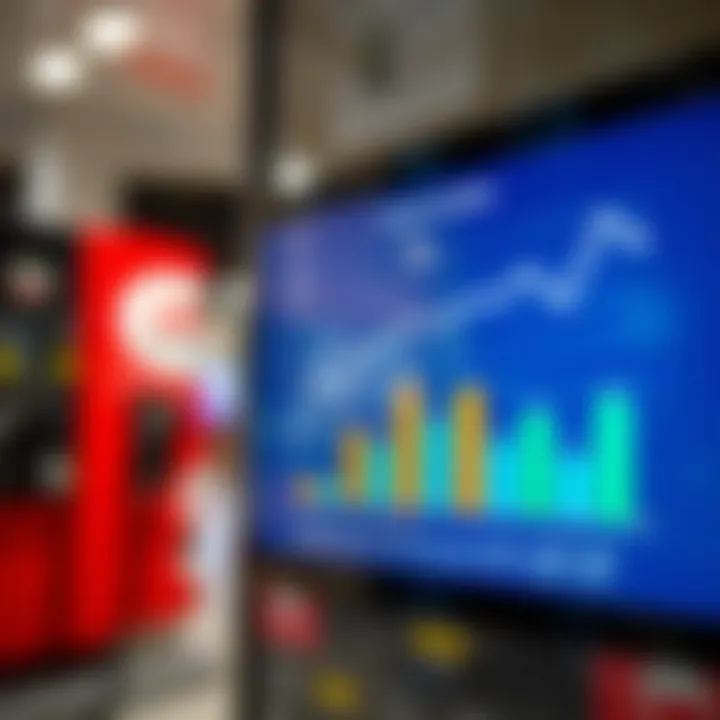Gasoline Prices in the UAE: Trends and Economic Impact


Intro
Gasoline prices are a topic of interest for many across the globe, but in the United Arab Emirates, this subject takes on a unique dimension. With its vast oil reserves and strategic position in the global market, the UAE has a complex relationship with fuel pricing, shaped by local policies and global dynamics. Understanding how these prices evolve is crucial not only for consumers and businesses but also for investors and analysts who seek to navigate this dynamic landscape.
In this article, we'll unpack the various factors that influence gasoline prices in the UAE: from historical trends to current fluctuations, and future outlooks. By diving deep into these elements, we aim to shed light on the broader implications of gasoline pricing on the economy as a whole, and how it affects daily realities for consumers and entrepreneurs alike.
The conversation surrounding fuel prices encompasses not just the direct economic impacts, but also environmental considerations, policy shifts, and global market trends. Therefore, as we explore these themes, we will seek to offer a comprehensive understanding that resonates with a high-IQ audience eager to decode the intricacies of this critical market.
Prelims to Gasoline Pricing in the UAE
The gasoline pricing landscape in the United Arab Emirates is more than just a matter of numbers on a pump. It serves as a critical barometer of economic vitality, consumer behavior, and regional dynamics that affect not only the UAE but also neighboring countries. As oil-producing and oil-exporting nations, the structural intricacies behind fuel prices shape various aspects of daily life and business operations. The insights gleaned from analyzing these prices can significantly inform investors, analysts, and policymakers about market tendencies and potential risks.
Understanding gasoline pricing in the UAE involves wrestling with multiple layers of information including historical data, current trends, and myriad influences ranging from global oil market fluctuations to local economic policies. Framing this discussion within such complexity provides a roadmap for stakeholders looking to anticipate market changes or to gain insights into consumer reactions.
Overview of Fuel Pricing Systems
Fuel pricing systems can vary considerably from one country to another, impacted by government regulations, market structures, and geopolitical considerations. In the UAE, where oil reserves are abundant, the pricing of gasoline has typically been influenced by a mix of subsidy practices and global supply dynamics. The structure tends to be characterized by a balance between competitive pricing and state-controlled elements.
The UAE switched to a more flexible pricing model in 2015, where fuel prices started to align more closely with international benchmarks. This shift reflects an attempt to phase out subsidies while aiming to rationalize fuel consumption. The ramifications of this move extend beyond just fuel costs—they touch almost every sector of the economy, often sending ripples through inflation and service pricing.
Countries and Their Fuel Price Structures
Examining fuel pricing in the UAE in relation to its neighbors sheds light on broader trends in the region. Countries like Saudi Arabia, Kuwait, and Qatar also dabble in fuel pricing systems that leverage both subsidies and international benchmarks to varying degrees.
- Saudi Arabia: Like the UAE, Saudi Arabia has revised its pricing strategies to reduce reliance on subsidies. The state-owned company Aramco sets prices that complement the global oil market.
- Kuwait: Known for its significant oil reserves, the country offers one of the lowest gasoline prices globally due to strong subsidies. However, Kuwait is now contemplating a gradual reduction of these subsidies as a means of fiscal reform.
- Qatar: Qatar employs a more government-regulated pricing structure but faces pressures to reconsider its approach in the face of global market fluctuations.
Understanding these comparative structures can yield lessons for analysts and investors, especially in grasping how governmental policies can directly influence economic conditions and consumer behaviors in both the UAE and its regional counterparts.
Historical Trends in UAE Gasoline Prices
Understanding historical trends in gasoline prices in the UAE is crucial for various reasons. First, it offers insight into how the economic landscape has evolved over time, reflecting shifts in demand, supply, regulation, and global market influences. By analyzing these price fluctuations, investors and analysts can gauge the overall health of the economy and forecast future trends. The historically low gasoline prices in the UAE, backed by strong domestic oil production, have enticed consumers and businesses alike, creating an environment where fuel is both accessible and affordable. However, as trends shift, an examination of past changes is key in preparing for upcoming challenges and opportunities in this sector.
Price Changes Over the Past Decade
Over the previous ten years, the price of gasoline in the UAE has experienced notable fluctuations, largely influenced by global oil prices, domestic consumption trends, and government regulations. From 2010 to 2015, gasoline prices remained relatively stable, largely due to the government's previous subsidy policies. However, the global oil market underwent significant shifts around 2014, leading to a drastic drop in crude oil prices.
- 2015: The UAE government removed some subsidies, resulting in increased gasoline prices. For example, in July 2015, the price of Super 98 gasoline surged to approximately 2.14 AED per liter, a marked increase from previous years.
- 2016 to 2019: Prices saw moderate fluctuations, largely tied to variations in global oil prices. By mid-2019, gasoline prices were around 2.24 AED per liter, illustrating a gradual increase.
- 2020: The COVID-19 pandemic caused a downturn in demand globally, affecting gasoline prices. In April 2020, prices dropped to near 1.50 AED per liter, showcasing how external factors can pivot the pricing landscape.
- 2021 and Beyond: As economies began reopening, gasoline prices rebounded, reaching around 2.83 AED per liter by the end of 2021, influenced by rising crude prices and increased consumer demand.
These shifts illustrate the complexities of fuel pricing in the UAE and show how external global market conditions and domestic policies work hand in hand.
Comparison with Regional Trends


Looking beyond the UAE, gasoline prices in the Gulf Cooperation Council (GCC) countries display similar patterns but vary in specifics due to each nation's unique policies and market conditions. While the UAE offers comparatively cheaper gasoline prices due to significant oil reserves and domestic production capacity, other countries have different approaches.
For instance, Saudi Arabia and Qatar historically maintained lower prices due to substantial subsidies.
- Saudi Arabia: Currently, fuel prices hover around 2.18 SAR per liter for Super gasoline, slightly lower than UAE prices but not far off.
- Kuwait: Prices are often lower as the government absorbs a significant portion of costs, leading to consumer prices around 0.85 KWD per liter.
Despite these similarities, certain challenges, such as the global shift towards renewable energy, have prompted some of these nations to reconsider their subsidy structures, making the future landscape of gasoline pricing in the region uncertain.
This comparative analysis makes it clear that while the UAE benefits from a strong domestic oil market, regional dynamics and global market pressures will continue to shape the future of gasoline pricing.
Factors Influencing Gasoline Prices
Understanding the factors influencing gasoline prices in the UAE provides a comprehensive insight into how fuel pricing affects consumers and the economy at large. Fuel prices do not fluctuate in isolation; rather, they are tangled in a web of complex elements that warrant investigation. Recognizing these factors is essential for investors, buyers, and analysts as they navigate this ever-shifting market landscape.
Global Oil Market Dynamics
The first piece of the puzzle lies in global oil market dynamics. The oil market, often described as a global chess game, is influenced by multiple players, including OPEC, major oil-producing nations, production quotas, and geopolitical tensions. When news breaks of a new discovery in the North Sea or political unrest in the Gulf region, these elements ripple through the market, ultimately affecting prices at the pump. For instance, a decrease in crude oil prices due to a surplus can yield noticeable declines in gasoline rates in the UAE, while a spike in demand from significant consumers like China can send fuel prices shooting upwards.
In this interconnected world, an analysis of oil futures or changes in crude oil prices is crucial for understanding what consumers may face down the road. Additionally, fluctuations in currency values, particularly the UAE's dirham to the dollar, can impact how local prices align with the global market. Factors like these shape the overall gasoline pricing environment, compelling buyers to stay informed.
Domestic Production and Supply Levels
Next in line is the influence of domestic production and supply levels. The UAE holds sizeable reserves of oil, which plays a significant role in regulating local gasoline prices. When the UAE pumps more oil and keeps supplies high, it can help stabilize or reduce prices. Conversely, if production decreases or if there is a production halt due to technical issues or policy changes, consumers may feel the pinch at the fuel station.
In the past, fluctuations in domestic output have had varied implications. For example, when local refinery operations were streamlined, it allowed for increased gasoline production, keeping prices in check. However, when supply chains were disrupted, costs at the pump began to soar. The delicate balance of maintaining production levels while meeting domestic demand—along with export needs—shows just how pivotal domestic production is in determining gasoline prices.
Government Policies and Regulations
Lastly, government policies and regulations play a significant role in fuel pricing. The UAE's approach to subsidies and taxation is critical for determining how much consumers pay for gasoline. Historically, the UAE has provided substantial subsidies to fuel prices, a stance that keeps costs low for residents. However, as the nation looks toward sustainability and economic diversification, it has gradually begun to phase out these subsidies. This shift means consumers could be facing higher prices in the near future.
Moreover, regulations surrounding fuel standards, import tariffs, and environmental policies can also influence gasoline costs. For instance, stringent environmental regulations might impact the types of fuel that can be sold, affecting prices due to production costs. The UAE’s government, with its focus on sustainability, may continue to alter the regulatory landscape, making it vital for consumers and stakeholders to adapt to these changes.
"Understanding the interplay of government policies, global dynamics, and local production is key to gauging future gasoline prices in the UAE."
By dissecting these factors, we unveil a clearer picture of why gasoline prices fluctuate and what potential shifts may lie ahead. As consumers and businesses alike keep a keen eye on these elements, they can make better-informed decisions and adapt to the market's ever-changing tides.
The Role of Subsidies in Fuel Pricing
Understanding the role of subsidies in fuel pricing is vital for illuminating the dynamics of gasoline costs in the UAE. Subsidies, which are essentially financial aids provided by the government, significantly influence how consumers and businesses interact with fuel prices. Essentially, they play a critical part in shaping market behavior, consumer choices, and broader economic conditions. By exploring subsidy structures and their implications, we can better grasp the significance of gasoline pricing within the UAE’s financial landscape.
Historical Context of Fuel Subsidies


The roots of fuel subsidies in the UAE run deep. Traditionally, the Gulf states, including the UAE, have relied on subsidies to keep fuel prices affordable for their citizens and residents. In practice, this means the government absorbs some of the costs to offer gasoline at lower prices than the global market.
Historically, these subsidies were a way to promote development, ensuring that the rising cost of living didn’t weigh heavily on citizens, particularly during economic transitions. For instance, in the early 2000s, UAE nationals enjoyed remarkably low fuel prices, which encouraged higher consumption rates. However, this approach has also led to unsustainable consumption patterns and a growing dependency on fossil fuels.
"Fuel subsidies can be a double-edged sword: they help consumers save money but may also contribute to wasteful consumption and financial strain on governments over time."
Current Subsidy Structures
Today, the subsidy landscape in the UAE has evolved. After significant reforms in 2015, the government shifted from blanket subsidies to a more market-oriented approach. As a result, gasoline prices are adjusted monthly based on global oil prices. Currently, while the UAE still offers subsidies, they are more targeted and transparent.
For example, certain segments, like low-income families and public transportation services, may receive additional support compared to high-income households. This shift intends to promote efficient ways of energy consumption. The current structure pivots on balancing affordability and reducing national expenditure on subsidies, which was previously a massive burden on the economy.
Impact of Phasing Out Subsidies
The gradual phasing out of subsidies brings about both challenges and opportunities. On one hand, reducing subsidies can lead to increased fuel prices, which, in turn, affects the cost of living. Consumers may experience heightened financial pressure, particularly in an economy where many rely heavily on vehicles for daily commuting and transport.
Alternatively, eliminating subsidies can lead to more responsible consumption. It encourages investments in alternative energy sources and infrastructure, pushing both consumers and businesses to adapt to new economic realities. As residents face higher prices, they may seek efficiency through carpooling or choosing public transport over private vehicles.
For more details on the economic implications of fuel subsidies, you can explore resources like Britannica or official government reports at gov.ae.
Consumer Behavior and Gasoline Prices
Understanding consumer behavior in the context of gasoline prices is pivotal for grasping the overall economic landscape in the UAE. Prices at the pump influence decisions made by everyday consumers, businesses, and even government policies. As such, fluctuations in gasoline prices can ripple through the economy, affecting everything from individual spending habits to larger corporate logistics strategies. Moreover, observing these behaviors paints a broader picture of how price changes influence the market dynamics and ultimately help shape future policies regarding fuel pricing and incentives for alternative energy.
How Price Fluctuations Affect Consumer Choices
When gasoline prices take a nosedive or skyrocket, consumers often find themselves adjusting their choices almost immediately. A significant spike in prices can push drivers to consider their travel habits more critically. For many, this may involve reducing trips, opting for public transport, or pooling rides with others. Those considering buying a new car might lean towards fuel-efficient models rather than gas-guzzlers, aiming to mitigate future fuel expense blowbacks.
The need to adapt can also lead to a shift in how consumers perceive value. For instance, if driving is perceived as too expensive, individuals may prioritize investing in homes near their workplaces, thereby influencing real estate demand patterns. Additionally, high gasoline prices might steer consumers toward using more sustainable transport options, such as electric vehicles, as they weigh long-term savings against upfront costs.
"Consumer habits aren't switched on and off like a light bulb, they're a gradual embrace of new realities shaped by the economy and personal circumstances."
Trends in Fuel Consumption
Fuel consumption trends in the UAE have shown a varied landscape shaped by both external and internal influences. One must consider that the UAE is one of the largest consumers of gasoline on a per capita basis, thanks to a combination of lavish lifestyles and a robust economy. However, this landscape is not static. Changes in gasoline prices often lead to noticeable alterations in fuel consumption habits.
One trend worth noting is the gradual awareness and shift towards fuel efficiency. As gasoline prices have fluctuated, consumers are becoming more conscious of their driving habits. For example, a spike in prices might lead to shorter commutes—more walking or cycling—while a drop could inspire longer trips or even vacations by car.
In addition, the government's initiatives toward sustainability and alternative energy may influence trends in fuel consumption as well. Policies aiming to boost the popularity of electric vehicles can create a shift in consumer behavior away from traditional gasoline-powered vehicles. Furthermore, the economic conditions where consumers are feeling the pressure to cut costs could pave way for trends such as car-sharing platforms and increased interest in vehicles that provide better fuel economy.
Thus, monitoring these consumption trends is crucial for stakeholders, enriching the dialogue around how gasoline prices can impact not only individual choices but also broader economic conditions.


Economic Implications of Gasoline Prices
The economic impact of gasoline prices in the UAE is multifaceted, playing a crucial role not just in personal budgets but also in broader economic dynamics. The ripple effects of fluctuating gasoline prices extend to inflationary pressures, shifts in consumer behavior, and significant consequences for the transportation and logistics sector.
Inflation and Cost of Living
Gasoline prices are often seen as a barometer for inflation. When fuel prices climb steadily, the costs of goods and services tend to follow suit. Why? A significant portion of transportation relies on gasoline, so increases can lead to higher delivery charges, which businesses often pass on to consumers. This creates a feedback loop where rising fuel prices lead to increased costs for everyday goods, directly squeezing household budgets.
- Retail Price Adjustments: Retailers struggle to absorb increased transport costs indefinitely. As a result, common items—such as groceries and essential household supplies—often experience price hikes. This can be particularly burdensome in regions where many people are already living paycheck-to-paycheck.
- Consumer Attitudes: When gasoline prices soar, consumers might cut back on discretionary spending. Think of it this way: if you’re shelling out more for gas, you might think twice about that extra latte or new shoes. This behavioral shift can lead to dampened economic growth, as key sectors in retail and leisure feel the pinch.
In the UAE, the government measures inflation carefully. Economic policies aim to maintain stability, further emphasizing how important gasoline pricing effectively is in consumer price indices and overall economic health. A sharp eye on these fluctuations can help investors and policymakers plan for potential economic scenarios.
Impact on Transportation and Logistics
The transportation and logistics sector serves as the backbone of the UAE's economy, acting as the lifeline for trade and movement of goods. Gas prices have a pronounced effect here, from shipping rates to the operating costs of delivering products.
- Shipping Rates: Increased fuel prices directly inflate shipping costs. Companies shipping goods overseas from ports in Dubai or Abu Dhabi must recalibrate their pricing structures to account for higher fuel expenditures. Consequently, this might reduce their competitive edge in the global market.
- Public Transportation: The intricacies of gasoline pricing also extend to public transport systems. Buses and taxis, often reliant on gasoline, can face fare hikes as operators seek to offset their increased costs. This adjustment can deter some commuters, pushing them toward more economical or sustainable transport options which might not always be favorable for operators in the short term.
As the UAE continues to diversify its economy away from oil dependency, the weight of gasoline prices remains a crucial factor in shaping logistics investments and the overall agility of the transportation framework.
"Tracking the fluctuations of gasoline prices not just informs budgeting for households but also underpins strategic logistics and investment decisions in a rapidly evolving marketplace."
Overall, understanding the economic implications of gasoline pricing helps stakeholders make informed choices, allowing them insight into potential market shifts while keeping an eye on operational costs and consumer behavior.
Future Outlook for Gasoline Prices in the UAE
Understanding the future of gasoline prices in the UAE is paramount for various stakeholders including investors, consumers, and policymakers. As the demand for fuel continues to fluctuate and global economic conditions evolve, assessing future trends can guide strategic decisions. Investors eye gasoline prices closely to optimize their portfolios, while consumers adjust their purchasing behavior based on perceived price movements. Furthermore, policymakers require this insight to craft informed economic strategies that might mitigate any potential adverse impacts of price fluctuations.
The implications of gasoline prices extend beyond immediate costs. They dictate the economic landscape, influencing everything from inflation rates to the viability of local businesses. By predicting future gasoline price trends, stakeholders can better navigate these economic waters. This section aims to unravel these predictions and highlight the potential role of energy alternatives in shaping the landscape ahead.
Predictions Based on Current Trends
Several factors are at play when predicting gasoline prices in the UAE. Analyzing historical data shows a pattern: when global oil prices rise, local costs often follow suit. This correlation suggests that unless there are substantial shifts in supply chains or refinery outputs, we could expect a gradual uptrend in gasoline prices.
- Demand Surge: This could be driven by economic recovery post-pandemic, with a surge in consumer activity, meaning thought to return to pre-pandemic levels.
- Market Sentiment: Investor sentiment remains crucial. If investors perceive instability in oil-producing regions, this could trigger price spikes even before actual supply is affected.
- Regulation Changes: Any shifts in government policy regarding fuel taxes or subsidies may further complicate predictions, often resulting in unexpected fluctuations.
While it might be tempting to rely solely on historical trends, a holistic approach takes into account emerging technologies and global geopolitical stability. Predictions thus need to be cautiously optimistic, involving an understanding of these myriad influences.
Role of Alternative Energy Sources
The transition to alternative energy sources could redefine the gasoline pricing landscape in the UAE. Renewable energy has made significant headway recently and could become a game-changer for how fuel prices are perceived and set.
Here are some notable aspects to consider:
- Government Initiatives: The UAE has set ambitious goals to diversify its energy sources, with investments in solar and wind energy. This could lead to decreased dependence on oil, thereby stabilizing or even reducing traditional fuel prices over time.
- Innovation in Transportation: The rise of electric vehicles (EVs) represents a fundamental shift in consumption patterns. With brands like Tesla, Nissan, and BMW pushing EV prices down, consumers may soon opt out of gasoline altogether, which would significantly influence demand.
- Disruptive Technologies: Innovations such as hydrogen fuel cells and biofuels are also starting to gain traction in the region. If these techs become mainstream, gasoline could see a steep decline in relevance and demand.
"The future belongs to those who prepare for it today." - Malcolm X
In summary, the interplay between traditional fuel pricing and alternative energy sources will largely shape the UAE's gasoline pricing future. Investors must stay vigilant, continuing to adapt to the ever-evolving energy landscape while considering potential shifts in consumer behavior.











